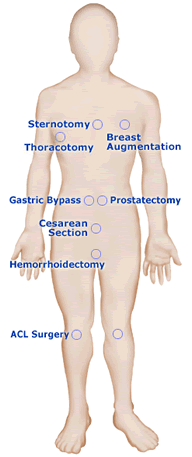
In all other branches of medicine, a treating doctor assumes that the patient has some kind of medical problem that the doctor has to fix or make better. If the patient experiences some pain, gets a big scar, or has some side effects, it’s an acceptable trade off because it’s for the patient’s benefit to attain good health.
Cosmetic surgery is different because the patient’s body is working right, and the doctor is just trying to make it look better. There are higher expectations for the surgeon to control pain.
Pain pills post operatively do help, but not enough
Pain pills taken post operatively can help reduce pain, but there are some undesirable side affects with pain pills such as percocet and oxycontin. Narcotics in general can make the patient nauseous. In addition there is always the concern of developing a dependency on the narcotic. In some cases, many patients do NOT want narcotics at all. They want a non-narcotic alternative to control the pain.
Pain Pump and Exparel reduce pain for Breast Augmenation and Tummy Tuck
Fortunately, there are other options besides narcotics to help control pain. The two options used most frequently in Plastic Surgery are the pain pump , and Exparel injection . The most common procedures that require pain control following surgery are Breast augmentation, Tummy tuck , and Body lift,.
What is the pain pump?
The pain pump is a device that is inserted at the end of the procedure while the patient is still sedated. This device will pump a local numbing anesthetic into the operative area. It is a device that has two components. The first is a small catheter, smaller than a drainage tube. It lies in the operated area and is brought out through a pinhole sized opening in the skin.
The catheter connects to a reservoir (a bulb) of local anesthetic, which is pumped continuously into the operated area. The local anesthetic will numb the operative area for approximately 3 days. There are multiple benefits to this. The patient takes fewer pain medications, because she/he feels a lot less pain. There is less nausea. The patient gets around better, and breathes better.
How does Exparel work?
Exparel is a long acting local anesthetic which is injected into the operative area at the end of the procedure. Like the pain pump, it focuses just on the operative area, and does not disseminate to the entire body like a narcotic does. The function of the Exparel is to numb the area of surgery so you do not feel pain. With cosmetic surgery, patients only need the one injection, and the pain control lasts for about 3 days. Similar to the pain pump, patients take fewer narcotics post operatively, because the pain is more controlled.
Other methods to control pain start during the procedure
As a plastic surgeon I have a goal of minimal pain surgery, and a strategy to achieve this goal. The perception of pain starts at the moment of injury, whether the patient is awake or under anesthesia. For this reason I inject short and long acting local anesthetic agents after the patient is sedated and before surgery starts. We don’t rush to start, but wait a good 15-30 minutes for the anesthetic to be well set in before we start. Once surgery is over, the effect of the long acting anesthetics will last for 12 to 18 hours. Again, this period is crucial in the perception of pain. If you can blunt pain perception in the first 24 hours, the patient does much better. With less pain medications there will also be less nausea.Controlling post operative pain has other benefits besides pain control!
Better breathing with pain pumps (or exparel) post operatively!
After I started using the pain pump with my Tummy tuck procedures in 2004, the first thing I noticed was that fresh post op patients (1-2 days) were walking into the office! Prior to 2004, many patients were in so much pain that they would call from the car and ask for a wheelchair to be brought up to the car. The pain pump reduced the pain so much that they no longer needed the wheel chair!
My second observation was that their skin looked better. With the pain pump, patients were just breathing better and moving around. They did not look sick! Needless to say, the recovery of these patients improved because they could get around sooner.
Pain pumps or Exparel both decrease post operative pain
When we started using Exparel a few years ago, our observation was that either method of pain control was great. With the pain pump or Exparel, the surgical experience is much improved, because both pain and nausea are both reduced!
I highly recommend the use of either the pain pump or Exparel with cosmetic surgery procedures.
(Article originally published April 22, 2008)




lindsay says:
Dr. Ricardo L Rodriguez says:
Simone Nusser says:
admin says: